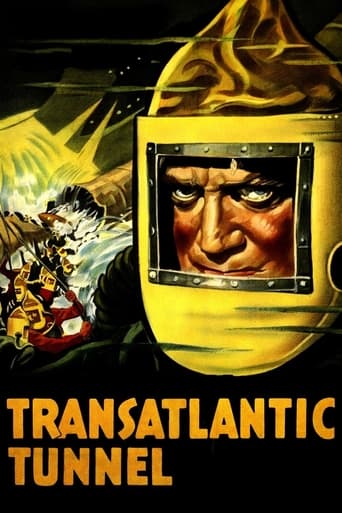

Several reviewers mentioned that this film is a perfect companion for Things to Come. That's because the model work for both was done by Ned Mann. In late silents through the 1930s Mann's work was unsurpassed. He flooded Palestine in Noah's Ark (1928). Then he went to the South Pole in Dirigible (1931) and destroyed Manhattan in Deluge (1933). His sets were so realistic because they were huge, probably unsurpassed in size until 2001 A Space Odyssey (1968). In Transatlantic Tunnel the model train seems to come from infinity, pass by the camera and go to infinity (in actuality a quick wipe and film reversal). I'm a professional model builder so I watch this and the other films mentioned on a regular basis and continue to be amazed. The full size sets are also well done, particularly when combined with Mann's miniatures.In its abbreviated form called The Tunnel, the editing leaves a lot of plot holes. Now that the complete version is available it makes a lot more sense. However, the plot is leaden and the acting sub-par. If you're into model special effects you'll watch it again and again; otherwise, once is enough.
... View MoreThis movie is set in "the future" - at least the future as it was envisaged in 1935, when it was made. It's actually never really established when this is set, but all things considered it had some pretty impressive predictions of futuristic devices (as well as, inevitably, a few misses.) So ,for example, there's reference to a tunnel having been built under the English Channel between Britain and France (which we today call the "chunnel") in 1940. That's several decades too early, but it gives us a reference point; the movie is set later than that (probably significantly later than that.) There's also apparently fairly widespread use of television, and even video-messaging "Skype-like" devices. Mind you, the movie misses the Second World War as far as we know. Helicopter-type airplanes never did become the rage, and there also seems to be an assumption of the survival of the "British Empire" - as late in the movie the King of England is referred to as the "Ruler of the British Empire" - a phrase that would have disappeared from the lingo not too long after this movie was made really. Still, it's a pretty impressive bit of future-gazing.The story revolves around an engineer who has invented a new kind of steel that's strong enough to allow for the building of a tunnel under the Atlantic Ocean between England and the United States. The scenes set inside the tunnel while it's being built are starkly impressive - looking like one would expect such a massive works project to look like. The work is dangerous, which is well portrayed, and a lot of men lose their lives working on the project. That, in a way, becomes the real subplot of the movie.A lot of lives are lost in the tunnel, but lives are also lost because of the tunnel. McAllan (Richard Dix) for example - the engineer in charge of the project - sacrifices literally everything (up to and including his own family) for the sake of this project. The project takes over his life. He eats, drinks and sleeps the tunnel. There's nothing else that even remotely competes with the tunnel in his life. That leads to all kinds of personal melodrama mixed in with the technical scenes about the building of the tunnel.Maybe I'm looking at this too much with almost 80 years of distance, but as I watched this and the negative effects the tunnel was having on so many lives, I couldn't help but think of this as a classic white elephant public works project. It's almost 5500 kilometres from London to New York City as the crow flies. Who would use this tunnel? What possible practical use would there be for it? Yes, it creates some jobs - so the unions support it. It makes money - so the corporations support it. Because it does both - the governments support it. And for the sake of national pride - the people support it. But for what? Apparently there's an international threat brewing from a coalition of "Eastern nations." How will the tunnel help with that? I guess the Americans could ship arms and men to England through the tunnel (if the threat is from Eastern Europe) or Britain could do the same for America (if the threat is from Asia) but this still seemed to be a waste of time, energy and lives.But that's 80 years later. It didn't make for a bad movie, but I would have liked a clearer explanation of why the thing was being built in the first place. As it is, it was apparently being built - just because we can! (6/10)
... View MoreIt's always interesting to see science fiction from the past and see what the conception of the world is from years past. How close are we to realizing a tunnel across one of earth's oceans?In 1994 the English Channel Tunnel commenced operations and at that it is only the second largest tunnel on the planet. The Seikan Tunnel which connects the Japanese islands of Hokkaido and Honshu is the largest. At that the Swiss will have beaten both of these when the Gotthard tunnel is finished which will be under several Alps speeding transportation across Switzerland and Europe in general.Politics as well nature delayed the construction of the English Channel Tunnel. So when and if we're ever ready to cross the Atlantic Ocean, by that time we may be rocketing to different worlds.In the world that The Tunnel is set in the construction of this undersea passage will forever cement the home world of the British Empire to the United States of America. At that point the English speaking people's of the planet will take on anybody. At least President Walter Huston of the USA and future Prime Minister George Arliss hope that the powers will be joined at the hip forever so to speak.The reason this is all possible is a radium drill that scientist Leslie Banks has invented. The Colonel Goethals of the project is hard driving American Richard Dix. Dix sacrifices all for the project including family because he believes in it so. The women in both their lives at different points are Madge Evans and Helen Vinson.The sheer idea of the technological achievement dwarfs the story and the players. The special effects are primitive by today's standards, still the film does entertain. When we get into the personal lives of those involved, the film veers over into the melodramatic.Some thirty years after this film there was this Grade C science fiction film that involved a trans Pacific tunnel. But that was being worked on in secret by the Communist Chinese to invade the United States. That epic was called Battle Beneath the Earth and it is the worst nightmare of every demagogic politician who worked up the crowds concerning the yellow peril.I guess the moral of both stories is when Occidentals build it, it's a good thing, when Orientals do it it's bad.
... View MoreThis film has long been available in a 71 minute form, and I believe only recently has surfaced in its full 94 minute version. Having seen it I can understand why it was cut. From an engineering viewpoint the premise is interesting and indeed there are some nice touches in it using early special effects, like video phones etc. At the time such ideas were left to Flash Gordon serials (mostly). It also tries to show the devastating effect that one mans obsession can have on his family. This is where the film sadly falls short of the mark. By concentrating more on this side of the story, the film all but ignores the tunnel completely. Were it not for the volcano impeding the progress of the tunnel, it would have been finished without anyone really noticing. Even George Arliss and Walter Hustons presence (limited to about three scenes in total each) can do little to save this movie.
... View More